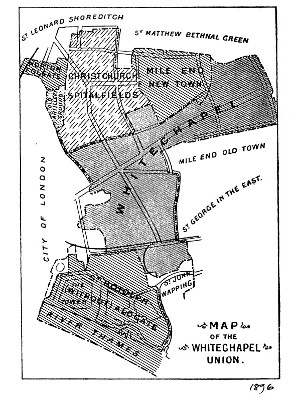This impressive three-storey Victorian building is the surviving main building of the former South Grovevvvv Workhouse, opened in 1871 by the Whitechapel Poor Law Union. The Union’s 1858-59 workhouse was in Vallance Road, but the lack of suitable building sites in Whitechapel meant that extra accommodation had to be provided on a three-acre site in Mile End Old Town.
There were smaller ancillary buildings, mostly along South Grove, and two large three-storey buildings were added in 1894. The northern of the two buildings was replaced in 1904. All these other buildings were demolished by Tower Hamlets Council in the 1960s, leaving the main workhouse building which was used as council offices in the 1980s.

The symmetrically-planned, stock-brick and slate building was planned and designed by the architect Richard Robert Long with an advanced central block, embellished by various stone-coped gables and an octagonal domed cupola, flanked by wide northern and southern wings under twin pitched roofs ending in stone-coped gables.
The ground floor of the advanced central block was mainly occupied by the committee room and general office; and the first floor by the master’s quarters. Ground-floor rooms in both wings served by central corridors and mostly used for administration, medical and staff purposes. Upper floors in both wings occupied by double-width wards, each with a central single or double line of cast-iron columns. Women were accommodated in the northern wing and men, in the southern wing.
Long’s small single-storey dining hall behind the central advanced block was replaced in 1898 with a three-storey eastern wing planned and designed by architect Bruce J Capel of Whitechapel. It contained a large dining hall on the ground floor with a single-storey kitchen range to the south.
From 1925, the South Grove Workhouse was administered by the Stepney Board of Guardians. In 1929 as the Whitechapel Institution it accommodated 669 aged and inform residents of whom 190 lived in the surviving main building.
 The main building is a nationally important representative of the small multifunctional urban corridor-plan workhouse building with original wards and rooms for administrative, medical and staff purposes; and a large ground-floor dining room.
The main building is a nationally important representative of the small multifunctional urban corridor-plan workhouse building with original wards and rooms for administrative, medical and staff purposes; and a large ground-floor dining room.
It is not as grand as the nearby better-surviving former City of London Union Workhouse of 1849. But it is, architecturally and functionally, the best example of the eight surviving workhouse buildings which served former districts in the London Borough of Tower Hamlets. The other examples are:
former c. 1857 offices of the Board of Guardians of the Mile End Old Town Poor Law Union, at Mile End Hospital; and narrow range of former casual wards at the back.
Alderney Building at Mile End Hospital – surviving western part of the c.1857 main building of the former Mile End Old Town Workhouse; and three former infirmary buildings to the north east plain block of flats in Wapping Lane – formerly an 1886 part of St George-in-the-East Workhouse.
As there were twelve large nineteenth-century workhouses serving districts in what is now Tower Hamlets, and most of them comprised several buildings, all eight surviving workhouse buildings constitute an important part of the Borough’s built heritage. But of the eight, the most important of the surviving “East End” workhouse building is the 1871/1898 workhouse building at Southern Grove. It is in the Tower Hamlets Cemetery Park Conservation Area and should be retained, sympathetically repaired, adapted for residential use and added to LBTH’s Local List.